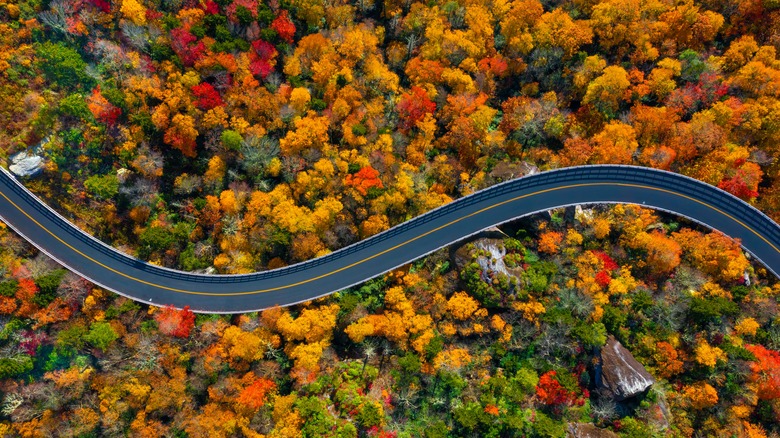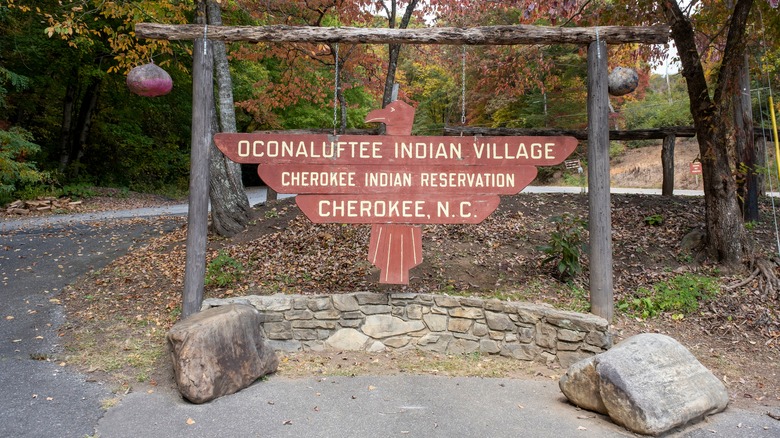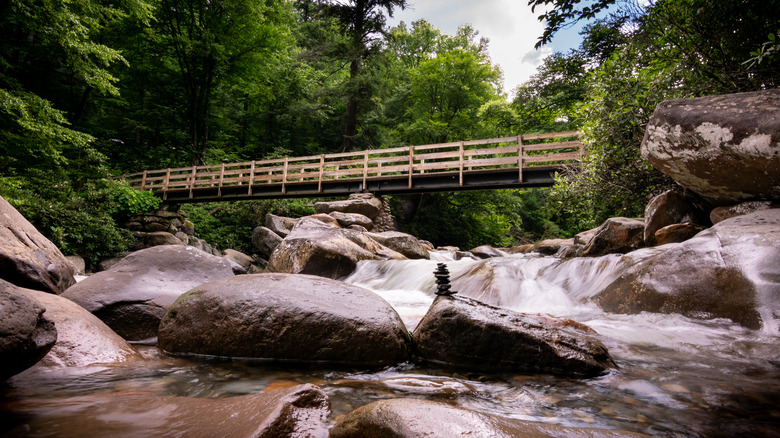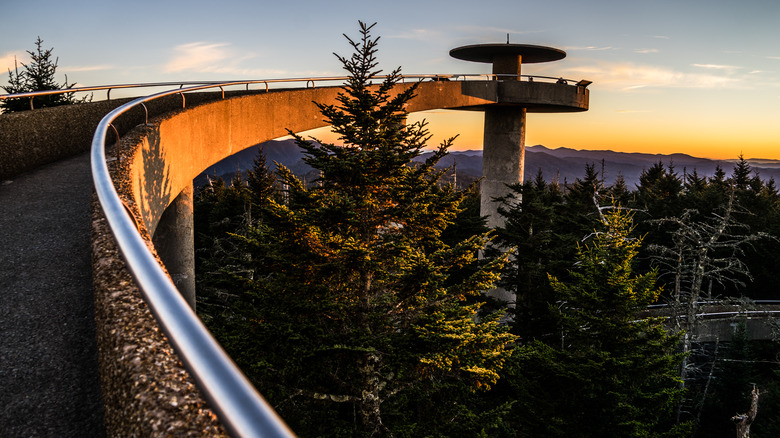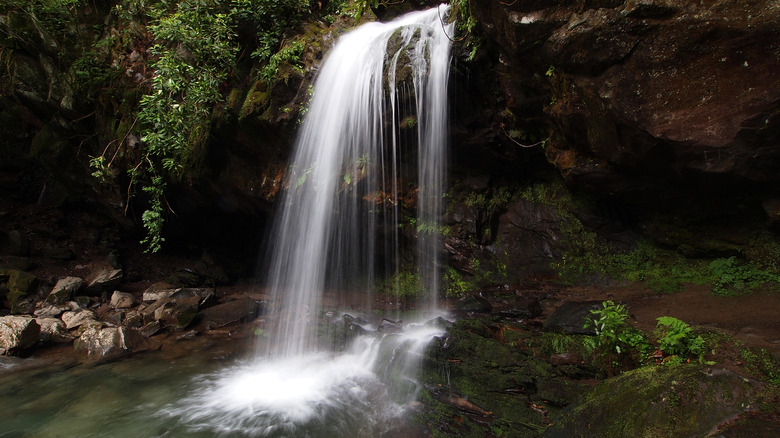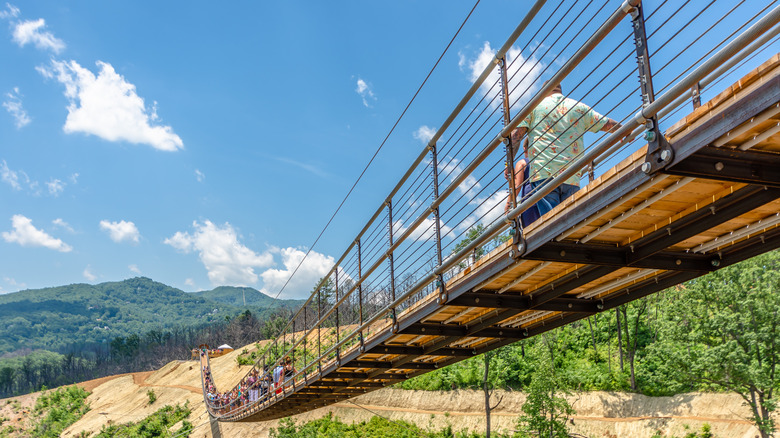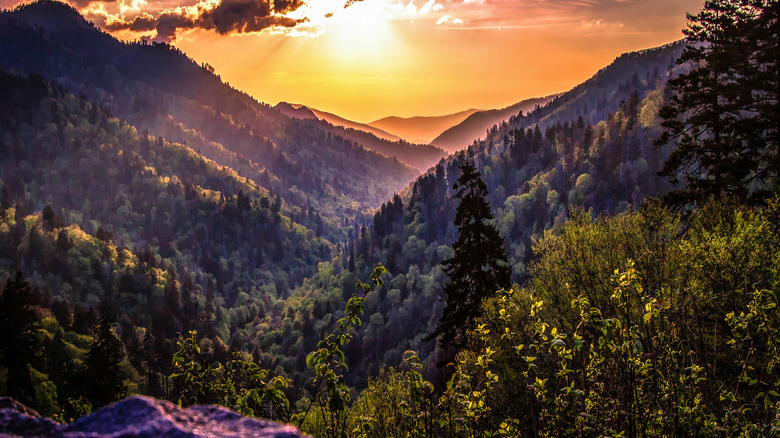Top 10 Family-Friendly Things To Do Near Great Smoky Mountains National Park
A grand expanse of greenery that straddles North Carolina and Tennessee, the Great Smoky Mountains National Park is an incredible domain of mountain ridges and dense forests. The park is named for the undulating range that extends between the two states, one that the Cherokee tribe called Shaconage, which means "place of the blue smoke" — a moniker given on account of the mist that is frequently seen hovering above the endless ridges. The beauty here is breathtaking, a reminder that nature is still very much present in large parts of the country. And the park is a great place to bring the family, not just for the chance to reconnect to the great outdoors, but also for the options that present themselves in the surrounding areas, from thrilling activities to historical exhibitions.
With a prime location in the central east of the continental United States, the park is easy to reach by car and also for travelers that fly in — the nearest airports are at McGhee-Tyson Airport which serves Knoxville, and Asheville Regional Airport. Even Charlotte Douglas International Airport, a hub for American Airlines, is less than a three-hour drive away. While getting here is easy, once you arrive, you and the kids might never want to leave, especially with all the fun experiences that await, listed below. One thing is for sure — between the astounding nature and the rich vein of manmade attractions, travelers will never be searching for things to keep them occupied.
Biltmore
Located an hour from the park in Asheville, this sprawling estate is like a three-dimensional work of art. As the largest private residence in the United States, it truly is a marvel of planning, architecture, and, during its heyday, staff management (though in a sense, with the number of staff that work here, it still is). With a footprint of 8,000 acres close to the French Broad River, this mega-mansion (though that description is underwhelming) was built in the late 1800s for George Vanderbilt, a scion of one of America's economic powerhouses. With large, manicured gardens and its distinctive architectural style, the main building, Biltmore House, looks like the center of a vast European country estate.
The numbers are certainly grand, with 175,000 square feet of interior space, the 250-room French Renaissance pile is just a huge, former home turned museum that showcases its past. Visits are taken as guided tours, and during them, guests will be awestruck by facts gleaned along the way — there are 65 fireplaces and 43 bathrooms here, and the kitchen staff had to coordinate the storing and cooking of large amounts of supplies as the Vanderbilts had 40 full-time employees on hand to keep the place ticking over. Furthermore, the 75 acres of gardens were designed by Frederick Law Olmsted, Sr., the genius behind New York's Central Park. The epic scale and opulence of everything here is something that the whole family will never forget, especially the first time you set eyes on the massive mansion that anchors the entire spectacle.
Blue Ridge Parkway
There are times when you drive along this stunning route, east of Great Smoky Mountains National Park and running through the Appalachians, that you might feel that you are alone in the world, high above sea level with nobody in sight. This incredible roadway is filled with sharp turns, climbs and descents, winding through forests and along the edge of mountains, and during stretches, you might not encounter another vehicle (though during peak seasons like summer and fall, visitors galore descend on the parkway to drink in the wild beauty). At times like those, the route can feel bracingly remote, removed from everyday life, as though it were situated on a higher physical (and spiritual) realm than our normal world.
The views are certainly out of this world — ridges upon ridges of mountains unfurling before you, sometimes blanketed in mist, other times crisply outlined by the brilliant sun and mountain air — with plenty of viewing spots that will decimate your phone memory as you take photo after photo of the glorious alpine scenery. The parkway unravels between North Carolina and West Virginia for more than 460 miles and passes by Mount Mitchell, the tallest peak in the eastern part of the country, but you don't have to drive the full length to appreciate the wonders that emerge. Insider tip: You can see the remains of a crashed Cessna aircraft on a hike along the Waterrock Knob trail, found by Mile Marker 451.2.
Cades Cove
This valley route in the park is a hugely popular immersion into the natural environment and for good reason — the wildlife here is a joy for the eyes. The most frequent sightings are of white-tailed deer, but these aren't the only four-legged creatures that visitors might encounter. After all, this is the natural habitat for black bears, raccoons, turkeys, coyotes, and groundhogs, among other creatures. The loop itself is 11 miles in length, and while that might not seem long, it is best taken at a snail's pace — meaning it should take hours rather than minutes, with regular stops along the way at pull-offs and viewing areas to allow travelers to soak in the experience.
Adventurers are advised to always maintain a healthy distance from the wildlife — it is wild, after all, and the animals are probably as scared of you are you might be of them — with a simple rule that you should be able to block out a view of the creature with your thumb when you arm is fully extended. If you can't, you are too close. For an even more intimate rendezvous with the animals, visit on Wednesdays from May through September as these are vehicle-free days, with the roads only open to cyclists and pedestrians. It's a low-impact way to revel in a high-impact excursion.
Cherokee
Notable as being the biggest Native American tribe in the United States, the Cherokee people thrived in this part of the country, spread out in the areas that now fall within the borders of Georgia, North Carolina, and Tennessee. Over time, and through economic displacement, the tribe split into three pieces, with some groups moving away, some staying. But the legacy continues, and visitors can learn about the culture of Cherokees in this town called Cherokee (which is also one of the entrances to the Great Smoky Mountains National Park). A fine starting point is the Museum of the Cherokee Indian. The institution traces the 13,000-year-old history of the tribe, vividly bringing to life its story through art, animation, relics, special effects, and full-size human models that truly immerse visitors in the Cherokee experience. The museum also boasts an impressive archive, with thousands of old books and photographs, and digital collections that explore the Cherokee language. It's a fascinating place for the entire family to learn about the area's rich anthropological past.
The Oconaluftee Indian Village takes that sense of first-hand engagement up a notch, or 10. This attraction meticulously recreates an 18th-century Cherokee settlement — the Oconaluftee were one of the three splinters created by the rupture of the original Cherokee people — complete with log cabin houses, crafting demonstrations, era-appropriately attired extras, and traditional performances. It is, in a sense, time travel, and which kid (or adult) doesn't fantasize about zipping through time?
Chimney Tops Trail
In a park named for smoky mountains, a trail called Chimney Tops gives you an idea of the heights you'll achieve. This is one of the most beloved walks in the park, clocking in at 3.5 miles (so it's very doable for the entire family) while rising 1,400 feet in elevation. The pay-off of this walk, which does require some exertion, though that shouldn't be a problem for kids bouncing around with energy, is the amazing views that hikers will see along the way. The youngsters will especially enjoy the early parts of the trail, which cross over bubbling streams (they'll probably want to get their feet wet just for the fun of it), before climbing up stairs on the ascent up the slope.
The gradient begins to increase and the trail gets rocky in part, with switchbacks and then a route that traces the slope of Sugarland Mountain. Eventually, hikers will arrive at a ridge that gives up views of Mount LeConte, one of the highest peaks in the park. The very top of the walk, the actual summit, has been closed following a fire in 2016, but the views you'll enjoy during the walk still make it a family adventure not to miss.
Clingmans Dome
While walking the Chimney Tops Trail will give you an appreciation for the verticality of Great Smoky Mountains National Park, venturing to Clingmans Dome will really make you feel on top of the world. There are many superlatives that come to mind when talking about this destination — it is the highest point of the park, hitting 6,643 feet above sea level, and also the highest part of the state. Only Mount Mitchell and Mount Craig, both in North Carolina's Mount Mitchell State Park, are loftier peaks east of the Mississippi. Thankfully, getting up here doesn't require a calf-burning, back-straining hike through a seemingly impenetrable forest: access is via a road that only closes during winter and hazardous conditions.
A parking lot signifies the end of the drive, and from here, expect a half-mile trip along a paved path to the observation tower. The tower itself looks retro-futuristic, a circular platform atop a concrete pillar with a gently rising, curling ramp leading to it. From the top, you'll be hit by views that are hard to adequately describe. To call them spectacular is to undersell the panorama, spruce forests in the foreground, and then mountain ridges behind, in all directions — the tower affords 360-degree views — seeming to never, ever end. On clear days, travelers can see landscapes up to 100 miles away. Note, it gets cool up there, so dress accordingly.
Grotto Falls
This three-mile walk is relatively straightforward, and an easy excursion for the family, though the name of the easiest route to the cascade is the Trillium Gap Trail. It's a pretty walk, with old-growth hemlock trees the constant as the trail works its way through the forest. And because of the elevation of the terrain, the walk remains relatively cool, even in the heights of summer. The walk takes in a number of small streams as it slowly climbs to the waterfall, another opportunity for the kids to get their feet "accidentally" wet. A series of rocky steps lead up to the waterfalls, which may only drop about 25 feet but have a much more intriguing attribute that makes them a must-see.
These falls are unique in the park because visitors can actually walk along the narrow area behind them, offering a special vantage from which to enjoy the rushing curtains of water. Naturally, the environment around here is moist — plenty of water and spray — so hikers should tread extremely carefully. Bears have been spotted on this trail, mostly going about their business in their natural habitat; if you do encounter a bear, remember to stay away from it (under no account should you approach it, even if your kids think it might be cool to take a selfie with one). If the bear catches your eye, slowly back away.
Gatlinburg
The most developed tourism hub right by the park, this Tennessee town has a wealth of family-friendly attractions. The Roaring Fork Motor Nature Trail is a gorgeous loop drive that showcases some of the Great Smoky Mountains National Park's highlights. The trip is less than six miles, accessed from the Gatlinburg entrance to the park, though closed during the winter months. A huge bonus of this road is that it does not permit larger vehicles — like buses and RVs — so a journey along it doesn't feel overly commercial, but small-scale and personal. There is plenty to see along the drive, so take it slowly — expect to encounter bubbling streams, historic log cabins, and deep tranches of the forest.
The loop is also what visitors are likely to take if they hike to Grotto Falls, as the trailhead starts from it. Of course, a visit to this town wouldn't be complete without stopping at Gatlinburg SkyLift Park. As the name suggests, the experience here is about hitting new heights — a chairlift from Gatlinburg takes visitors up to the apex of Crockett Mountain, from where they can admire stunning views. For a more thrilling experience, take a walk on the SkyBridge, a 700-foot-long suspension span that's distinguished as being the longest pedestrian cable bridge in the country (and yes, the mountain views are sensational). Back in the heart of town, Anakeesta is an adventure park with a treetop walk, a sensory garden, zip lines, an observation tower, and a roller coaster.
Newfound Gap
For adventurers of all ages that enjoy the prospect of traveling along a mountain pass, the relationship between excitement and altitude can usually be laid out as thus — the higher the pass, the more thrilling the experience. But here, at Newfound Gap, there is plenty to delight visitors even though this pass, in these parts called a gap (basically a dip in a mountain ridge that makes travel over mountains easier), is the lowest drivable of its type within the borders of the park. It clocks in a shade over 5,000 feet above sea level.
Yes, the views along this drive are truly stunning — it connects two entrances to the park, linking Cherokee with Gatlinburg as it twists, turns, curves, climbs, dips, and descends along 31 miles of roadway — but what is even more outstanding is the breadth of types of the forest it traverses, a sort of microcosm of arboreal ecosystems that you might experience if you were to travel the long, arduous stretch from Maine to Georgia. The drive ascends 3,000 feet in all, and visitors will encounter northern hardwood, spruce-fir, cove hardwood, and pine oak. There are numerous small pull-offs along the side of the road allowing you to make stops en route and take in the mind-blowing vistas and fresh mountain air.
Pigeon Forge
A short drive north of Gatlinburg — and we mean short, it's approximately 20 minutes — this Tennessee town is another that is no stranger to mass tourism. It's not a large place, with a permanent population of only about 6,000 residents, but it punches significantly above its weight in terms of things to do for the family. For starters, Pigeon Forge is home to Dollywood, a vast entertainment complex with an amusement park, water park, and large resorts right on site. The variety of rides for all ages is impressive, with river rides and nine roller coasters, the new Big Bear Mountain coaster opening in May 2023. There are also indoor playgrounds, water slides, and a lazy river.
Nearby, automotive excitement awaits with a number of go-kart spots — some that also feature game arcades — that will let even those without a license experience the thrill of the chase. Snow bunnies can indulge their passion year-round at Pigeon Forge Snow, where tubing and frolicking in the snow can be done even in the middle of summer. Titanic is a museum that will keep everyone enthralled, with reconstructions of parts of the ship, items that were actually on the fated vessel, and information on what happened the day it struck an iceberg and sunk. Just outside Pigeon Forge, the Smoky Mountain Alpine Coaster is a long-ride downhill sled that runs on rail tracks, extending a mile in length, with speeds peaking at around 30 mph.


